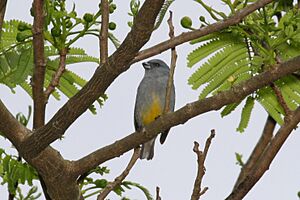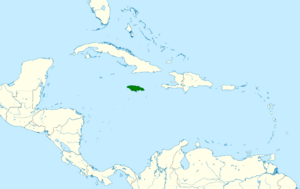Jamaican euphonia facts for kids
Quick facts for kids Jamaican euphonia |
|
|---|---|
 |
|
| Conservation status | |
| Scientific classification | |
| Genus: |
Euphonia
|
| Species: |
jamaica
|
 |
|
| Synonyms | |
|
Fringilla jamaica Linnaeus, 1766 |
|
The Jamaican euphonia (Euphonia jamaica) is a small, colorful bird found only in Jamaica. It belongs to the Fringillidae family, which includes finches. Locals sometimes call it the "Short-Mouth Bluequit" because of its short beak and bluish color. These birds do not travel to other countries; they live all over Jamaica in forests, gardens, and hilly areas.
Contents
Appearance
Jamaican euphonias look different depending on if they are male or female. Male birds are mostly bluish-grey with a bright yellow belly. Their feathers under the tail are a pale color. Female birds have two main colors: their front part is grey, and their back and tail are olive green. Both male and female euphonias have short, thick beaks.
Young birds, called juveniles, look similar to females but their colors are not as bright. An average Jamaican euphonia is about 11 centimeters (around 4.3 inches) long. It usually weighs about 17 grams, which is less than an ounce.
Where They Live
Jamaican euphonias live only on the island of Jamaica. They do not migrate or fly to other places for different seasons. These birds can be found in many different parts of the island. They live in wooded areas, bushy shrublands, and even in people's gardens and fruit orchards.
They are most often seen in hilly lowlands. You can find them from sea level all the way up to 2250 meters (about 1.4 miles) high. This includes the top of Blue Mountain Peak, which is the tallest mountain in Jamaica. Even though they don't migrate, they might move around different parts of the island during the year.
What They Eat
The diet of the Jamaican euphonia is mostly made up of fruits and berries. A big part of their diet is mistletoe berries, also known as Loranthaceae. They also enjoy fruits from fig trees (like Ficus and Cecropia). Other fruits they eat include cho-cho vines (Sechium) and guava (Psidium).
To find food, these birds might search alone or in small groups. They also gather with other birds at places where food is easy to find. Because they eat so much fruit, large groups of Jamaican euphonias can sometimes cause damage to fruit crops in gardens and orchards.
Nesting and Reproduction
The breeding season for the Jamaican euphonia is from February to May. The time when they build nests and lay eggs is usually between March and May. Both male and female birds work together to build the nest.
Their nests are made from a mix of grass and plant stems. They often hide their nests inside Spanish Moss (Tillandsia), which helps keep them safe. The nest is shaped like a dome and has an entrance on one side. During the nesting period, females lay 3 to 4 white eggs. These eggs have lavender, red, and brown markings, mostly on the larger end.
How They Are Doing
The Jamaican euphonia is listed as a species of "Least Concern" by the 2016 IUCN Red List of threatened species. This means they are not currently in danger of disappearing. Their population seems to be stable, but the exact number of birds is not known.
These birds are not specifically protected by laws. However, they live in many land and water areas that are protected. The average lifespan of a Jamaican euphonia is about 3.5 years. There are no major known threats to this species.
Images for kids



